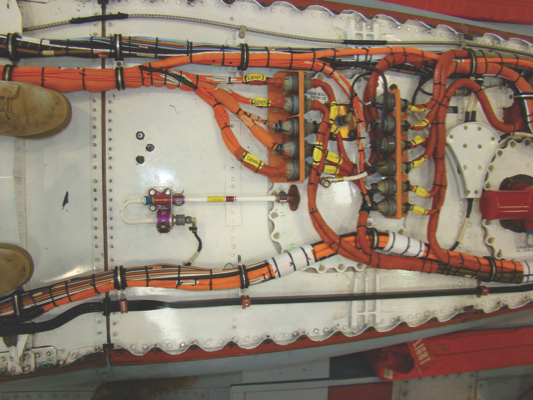Instrumenting aircraft to collect certification, continued airworthiness and mission effectiveness data is a critical enabler towards the successful management and development of the RAAF's aerospace capability, but the cost of such work has traditionally been prohibitive and time consuming. The ‘NIFTY’ wireless sensor system is set to change all that.
Patrick Durrant | Sydney
Wing Commander James Blagg of the Development and Test Wing, Aerospace Operational Support Group is excited about the NIFTY. The device, after all, has the potential to reduce test equipment installation times on aircraft from weeks to just hours. He gives ADM some background.
“When you do a flight test you need to capture aircraft data – sometimes it is as simple as accelerometer (g-load) data, but other information such as strain, or the amount of force that is being carried by the structure is also collected,” WGCDR Blagg explained.
The amount of wire that goes to and from the sensor and the recording device can be quite substantial, according to WGCDR Blagg, and it sometimes needs to penetrate through pressurised bulkheads where appropriate routes must be found.
“Both in design and in installation, the wire sensor is quite an encumbrance,” he said.
To provide a responsive flight test capability, ARDU has had two designated Hornet airframes permanently allotted since the early 1980s. But with many new aircraft types coming into service with the RAAF, and the Hornets to be replaced eventually by the F-35 Lightning II, a new, efficient approach to flight testing needed to be found.
“Once we have gone past the Hornets, we will no longer have aircraft permanently allocated to us for flight test so we will need to use fleet aircraft”, WGCDR Blagg said.
“The FEG commanders who are operating those aircraft can not afford to release aircraft to ARDU for extensive downtime necessary for wired instrumentation, so we’ve been looking at opportunities to install instrumentation that doesn’t require wiring.”
Enter NIFTY, a joint development involving Australian industry (aadi Defence Pty Ltd and Procept), Defence Science and Technology (DST) Group, and the RAAF’s Aerospace Systems Engineering Squadron (ASESQN). Development to date has been funded through a Project Agreement with the US Air Force (USAF) Seek Eagle office, in support of potential applications within the Joint Strike Fighter (JSF) program.
NIFTY utilises a bespoke wireless communications technology, instead of a commercial off the shelf alternative, such as WiFi or Bluetooth. Physically, the system comprises a single recorder and up to 24 wireless sensors that are designed to adhere to any external surface, while having negligible influence on aircraft handling qualities, performance or operating limits.
“One of the things we’ve had to ensure is that they won’t create an unsatisfactory electromagnetic interference (EMI) effect on the aeroplane,” WGCDR Blagg said. “We’ve proven that with some ground tests and also in our EMI chamber here at RAAF Edinburgh and are satisfied that this won’t happen.”

"Orange wiring" permanently installed within an ARDU Hornet. Credit: Defence
Flexibility in sensor installation is maximised through the use of wireless mesh network topology, meaning every sensor does not require line of sight with the recorder. An external unpressurised pod houses the recorder for aircraft fitted with 14-inch pylons (which includes all fast-jet, AP-3C and PC-9A), for all other aircraft, a generic mounting tray facilitates internal installation within the main cabin, or cockpit.
Finally, the system’s operating mode can be controlled wirelessly in flight by the test pilot or Flight Test Engineer (FTE).
The biggest advantage is the time saving, according to WGCDR Blagg. Traditionally the wiring for a simple loads monitoring installation, comprising of 10 strain gauges, would typically require 5-10 working days. Comparatively, a 10 sensor NIFTY installation could conservatively be achieved within 3-4 hours.
“If we talk about putting something on a C-17 Globemaster for example then we are talking about days rather than weeks or months,” WGCDR Blagg says.
“If all goes well then we’ll be able to go and develop it further and look at other applications.”
At the time of writing, ARDU was going to test a 10 sensor NIFTY system on a PC-9 during a flight trial in late October.
“If all goes well then we’ll be able to go and develop it further and look at other applications.”
The PC-9A flight trial in October represents a concept demonstration, with limited functionality and sensor options. It aims to prove the suitability of wireless technology to provide high fidelity flight test data, and a novel fast application, non-intrusive, adhesive for the external mounting of sensors.
The ability of NIFTY to reliably and accurately record vibrations within the aircraft’s structure will be assessed during aerobatics (including normal and accelerated stalls, manoeuvring on the buffet, and spins) and normal flight to the limits of the PC-9A envelope (320 knots / 25 000 ft / -3.5 to +7 g).
As well as its functional performance, ARDU test pilots and FTEs will determine if NIFTY is suitable for use from a human factors perspective, within the unique, and workload intensive, flight test environment.
Future development of the NIFTY system is being considered in 2016 and beyond to include a substantial increase to the functionality and performance, to equal and potentially exceed that provided by current traditional capabilities. Critically, the adhesive will be strengthened to support the external mounting of sensors at supersonic airspeeds. Final verification of phase two developments would require flight trials on a Classic Hornet.
WGCDR Blagg says the key thing about NIFTY is that it keeps the ARDU instrumented flight test capability relevant from the customer’s perspective.
“They want to know that if they ask us to provide flight test support then we can get instrumentation on the aircraft very quickly to support either operational or project timeframes – that’s the big thing we want to achieve with NIFTY.”



